Tigridia is an unpretentious perennial flowering crop from the Kasatikov family, uniting about five dozen different species and varieties. This article will tell you in detail how to plant correctly, prepare the bulbs and soil, choose a suitable site and properly care for unusual plants.
|
The main feature of this exotic flower is its short lifespan; each inflorescence pleases with its beauty only for eight hours, after which it fades. |
| Content:
|
Description of the flower
The flowering perennial consists of a dense corm, belt-shaped (with a folded surface) leaves of a dark green hue, a straight or branched stem, single flowers resembling fluttering butterflies, and fruits - boxes with angular brown seeds with a smooth surface.
|
The average height of herbaceous plants is from thirty to seventy centimeters. |
Each bulb produces five to six peduncles. The inflorescence consists of three large petals of a single color and a central part represented by several shades, inclusions and spots of a different color.
Although each flower remains open for only eight hours, the entire flowering period of tigridia lasts from mid-summer to early autumn.
Brief agricultural technology
- Landing dates: in the second half of March, the bulbs are planted in small pots for germination indoors; in the second half of May - transferred to open ground.
- Flowering period: from the beginning of July until the end of the summer season.
- Growing conditions: open or semi-shade area, well-drained, light and loose soil with moderate humidity, slightly alkaline or neutral in composition.
- Watering rules: only as the soil dries out; during periods of prolonged drought - morning watering and evening spraying with warm water.
- Fertilizer application: it is required only for depleted soil twice during the entire season - four weeks after the mass appearance of leaves and during the formation of buds.
- Garter to support: necessary for plants with tall and thin stems.
- Reproduction methods: seeds, pups and bulbs.
- Preparing for winter: Bulbs with withered aerial parts (or still green) are dug up before frost sets in (around October). The above-ground part that has yellowed and lost vigor is cut off, and the bulbs are sorted, disinfected, dried and stored until spring in a container with peat or sand in cool conditions with a temperature of three to ten degrees Celsius.
- Possible diseases and pests: rotting of bulbs due to improper storage, slugs, mole crickets, thrips and cabbage cutworms.
And now about all this in more detail
Planting and caring for tigridia in the garden
Preparing for landing
Selection of containers
Preparatory work begins with choosing the right container in which the bulbs will be germinated. Since flowers are positive about bottom watering, the pots must be taken with a tray that will have fairly high sides and large drainage holes at the bottom of the pot. The material of the selected container does not matter much, because the tubers will very soon move to a permanent site.
Sprouting bulbs
In the period from the twentieth to the thirtieth of March, the bulbs are planted in a light and loose substrate and kept indoors. Sprouted planting material guarantees earlier flowering.
|
You can place several tubers at once in a large container. Planting depth is at least three centimeters. |
Conditions and care
Plantings must be kept at room temperature with good lighting, without cold drafts. The main care is proper soil moisture. In the first ten to fifteen days, the volume of irrigation water is minimal; the soil should be moderately moist, without excess water. The abundance and frequency of watering increase as the bulbs sprout. When sprouts appear, planting containers must be placed on the windowsill on the south or east side.
Planting in open ground
Deadlines
The heat-loving tigridia does not tolerate even minimal frosts and very cold nights, so planting material in an open area in the garden or flower garden should be carried out only in consistently warm weather and an average daily temperature of at least fifteen degrees Celsius.
|
The most favorable period for planting is from the twentieth of May to the tenth of June, depending on the climate of the area. |
Place and soil
A flowering crop can grow in an open area and in partial shade, but the more sunlight during the day, the stronger and stronger its shoots will be. With a lack of sun, the plants will have weakened and thin peduncles that will not even withstand an average wind. By the way, the area chosen for planting must be protected from drafts.
Before planting the bulbs, it is recommended to thoroughly clear the soil of weed residues, dig deep and add, if necessary (if the soil is too dense), coarse river sand or sawdust. Flowers prefer drained soils with a neutral or slightly acidic composition, light and loose, with moderate humidity.
Landing scheme and features
Small unsprouted planting material is buried by three to five centimeters, large ones by seven to ten centimeters. The distance between crops is from fifteen centimeters, the row spacing is from twenty centimeters.
|
As a preventive measure against various infectious and fungal diseases, before planting in the ground, the bulbs are immersed in a disinfecting solution (for example, manganese) for two to two and a half hours. |
After forcing, the bulbs are transplanted into specially prepared holes about sixty centimeters deep. The bottom of the pit is covered with a layer of drainage material (for example, crushed brick) about twenty centimeters thick, then it is filled with light nutrient soil.
After planting, the plants are moistened abundantly.
Important! When planting bulbs without prior germination, flowering begins much later, approximately in the last days of August. The plants will not have time to bloom before the first autumn frosts arrive.
Basic rules for caring for tigridia
Watering regime and pruning
Exotic flowers need to be watered systematically and in such volumes that the irrigation water reaches the depth of the corms. Watering frequency is three or four times a week.
In the absence of natural precipitation for a long time and high temperatures, it is recommended to moisten the crops daily - at the root (in the morning) and in the form of spraying the aerial parts from a spray bottle (in the evening). Water for irrigation should be warm and settled.
|
To preserve and maintain the decorativeness and attractiveness of a flower bed or garden, it is worth promptly removing already faded inflorescences. |
Application of fertilizers and fertilizers
When growing tigridia in a plot with fertile nutritious soil, into which the necessary fertilizers were applied before planting, no additional feeding will be required until the end of the warm season.
If planting was done on depleted soil, you will have to feed the plants two to three times. For this purpose, mineral and organic fertilizers are used, it all depends on the preferences of the gardeners. A solution based on a mineral complex is prepared from ten liters of water and thirty grams of fertilizer. It is applied at the root about a month after the appearance of the leaf part, during the formation of buds and at the beginning of flowering.
Don't forget to read:
Groundcover perennials - which ones to choose for your garden ⇒
Soil care and installation of supports
For the full development of flowering perennials, the soil must be regularly loosened and weeded. If this is not possible, then it is recommended to mulch the plantings.
You can use freshly cut grass, sawdust, peat, and straw as mulch. This layer will not only reliably protect against weeds and retain moderate moisture, it will also prevent the soil from compacting and leave it breathable. If there is a mulch layer on the flower bed, the amount of watering is significantly reduced.
|
For tall varieties of tigridia, it is necessary to install pegs or strong rods and tie them. This will protect the shoots from damage. |
Preparing bulbs for the winter season and storage
If the flowering of exotic crops has stopped, there is no need to rush to remove the corms from the soil. And they must be removed, since heat-loving plants will not tolerate winter cold and will die.
This procedure is recommended to be carried out when the above-ground part of the bushes has completely withered.If frost is already approaching, and the leaf blades are still green, then the tubers are dug up along with the leaves and left in a bright, cool room until they turn yellow.
After the leaves and shoots have completely died off, the bulb is separated from the upper part of the bush, cleaned of any remaining soil, washed under running water, then left for several hours in a disinfectant solution and dried.
Storing corms
Optimal storage conditions planting material - cool temperature (from three to ten degrees Celsius) and normal humidity level.
Such conditions exist in the cellar or basement, if it is a private house, or in an ordinary household refrigerator (on the shelf for vegetables and fruits).
In the cellar, the bulbs are stored in containers with sand or peat, and in the refrigerator - in individual paper bags.
Attention! The temperature in storage areas should not fall below zero.
Possible diseases and pests
Tigridia can sometimes be bothered by pests and diseases. There are various drugs and recommendations for prevention and control.
Rot
Most often, poorly ripened bulbs that have not undergone disinfection treatment rot. Another cause of rotting can be excessive watering and soil that is unsuitable in structure and composition.
Rust
The disease can be prevented by treating with herbal infusions at the initial stage of development of flower crops, and cured with the help of special preparations - fungicides.
Mosaic
This disease is incurable, so all efforts must be devoted to preventive measures: providing flowers with normal growing conditions and proper care.
To combat mole crickets, cutworms, caterpillars and slugs, folk recipes and methods are used (for example, treatment with soap solutions) or insecticides are used.
Reproduction methods
Seeds
The seed propagation method is not very popular and is not used often, as it is very labor-intensive, troublesome and lasts about six months.
The optimal time for sowing is the winter months. The seed material does not need preparation; it is sown immediately into a prepared substrate consisting of sand and peat. The sowing depth is about three millimeters, the distance between the seeds is six or more centimeters.
|
To avoid future transplantation, each seed is planted in a small individual container. |
If the soil is properly moistened and the temperature regime is observed (22 - 25 degrees Celsius), seedlings appear in fifteen to twenty days.
Children
This method of reproduction is considered the simplest and most effective. Adult bulbs along with the children are left for storage until spring.
In the spring, the children are carefully separated, the broken areas are sprinkled with wood ash or activated carbon powder and planted in pots for forcing or in open ground.
Types and varieties of tigridia
tubular
|
“Tubular” is a heat-loving miniature crop of Mexican origin with an average height of about fifty centimeters. |
- The outer petals of a small flower (about seven centimeters in diameter) are painted in a light pink shade, and the core is marked with yellow spots.
- Begins to bloom in July.
Peacock
|
“Peacock” - the color of the flowers resembles a peacock’s tail, which is why this species got its name. |
- Flower bushes have an average height of thirty to seventy centimeters.
- The culture consists of a cylindrical stem, wide folded sword-shaped leaves of a light green hue, peduncles and flowers with a cup-shaped core.
- The average diameter of one flower is five to six centimeters.
- Loves sunlight and warmth, does not tolerate drafts.
- The flowering period lasts approximately three weeks (in July - August), each flower lives only one day.
Rosalind
|
“Rosalind” - the petals of fragrant flowers are painted in light pink tones, and the surface of the white center is marked with red spots. |
- The diameter of the inflorescences is about ten to thirteen centimeters, the height of the peduncle is about thirty centimeters.
- Plants do not tolerate sharp gusts of wind and shady conditions, prefer loose soils and timely watering, and respond positively to mulching.
- The bulbs removed after the bushes have withered are stored in a cool, dark place.
Alba
|
"Alba" is a perennial with white flowers with a diameter of ten to fifteen centimeters, the middle of which is painted in red shades. |
- Five buds are formed on each peduncle.
- The plant loves light and loose soil, regular fertilizing, weeding and loosening of the soil, is not afraid of drought, and does not require staking.
- It blooms for three to three and a half weeks, starting in mid-summer.
Speciosa
|
"Specioza" - large fifteen-centimeter flowers are painted red, and in the center there are red specks on a yellow background. |
- Straight stems reach a height of fifty centimeters.
- The bulbs are planted at the end of May to a depth of about eight centimeters, with an interval of about fifteen centimeters.
- Low resistance to cold, but high to drought.
Lilacea
|
"Lilacea" - plants about sixty centimeters high with lilac-red flowers and spots in the throat, with elongated leaf blades of a bright green hue. |
- The diameter of the flower is from ten to fifteen centimeters. The life of each of them lasts about eight hours.
- Up to five buds are formed at the top of one stem.
- Heat-loving flowers love moderate watering and organic fertilizing.
Aurea
|
"Aurea" is a perennial crop with yellow inflorescences with a diameter of about fifteen centimeters. The average height of the bush is about fifty centimeters. |
- Prefers open sunny areas with fertile, drained soil, moderate watering and regular weeding.
- Blooms from mid-July to mid-August.
- The bulbs are dug up in early autumn, after the above-ground part has withered, and stored until spring at a temperature of about five degrees Celsius and high humidity.
Canariensis
|
“Canariensis” is a crop about seventy centimeters high with sunny yellow petals and red spots in the throat. |
- Exquisite flowers with a diameter of about fifteen centimeters open alternately.
- Up to five buds are formed on each peduncle.
- Plants tolerate drought and high temperatures well, love well-drained acidic soils and moderate humidity.
- They bloom in the second half of summer.
Tigridia is used to decorate gardens and flower beds, garden areas and the banks of artificial ponds, balconies and terraces. It is grown in mixborders and rockeries, in floor flowerpots and containers, and planted next to flowering annuals and coniferous crops. In the spring, its beauty lies in the bright green foliage, and in the summer - in the inflorescences - butterflies.
Tigridia is unique beauty and originality, exotic appearance and high decorativeness.
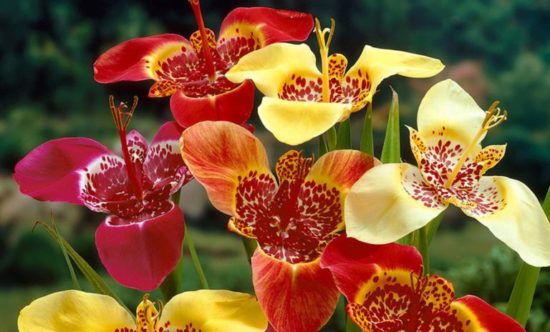
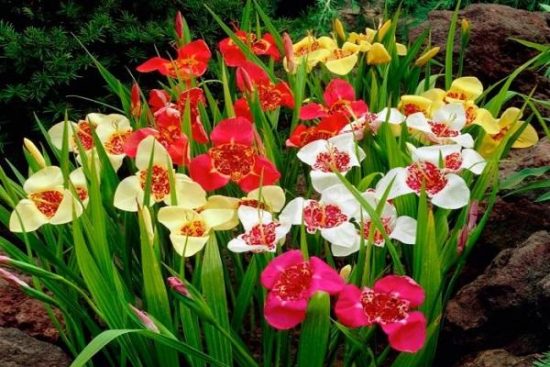
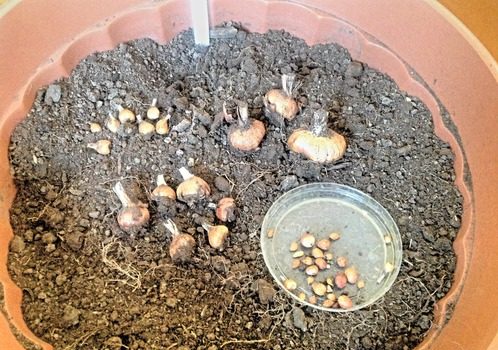
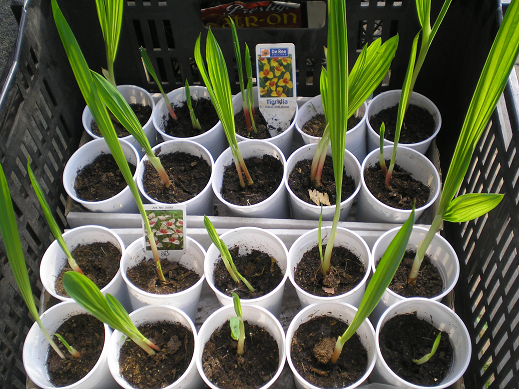
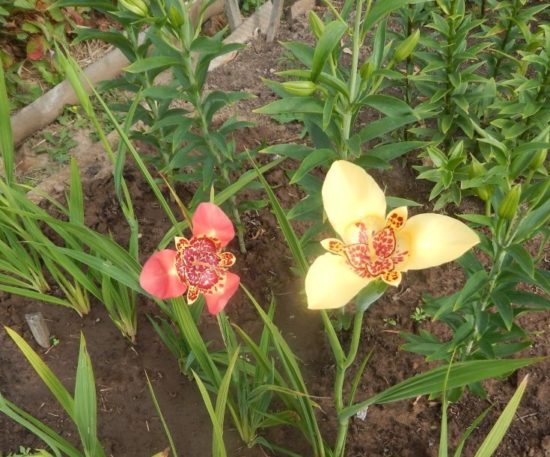
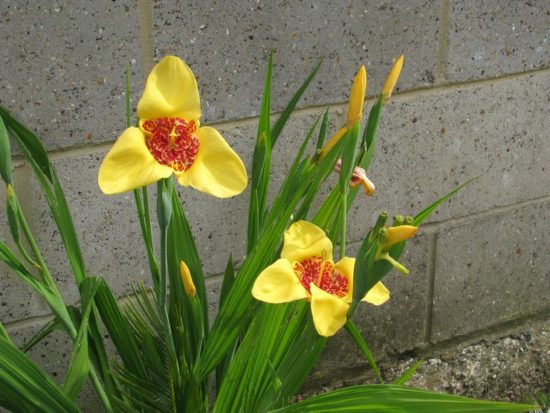
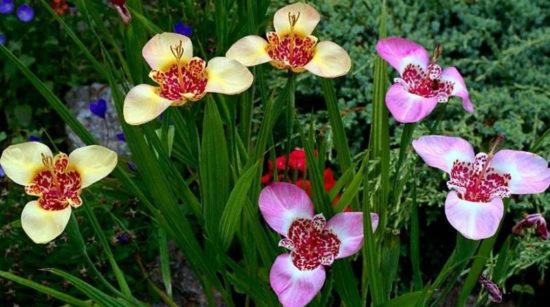

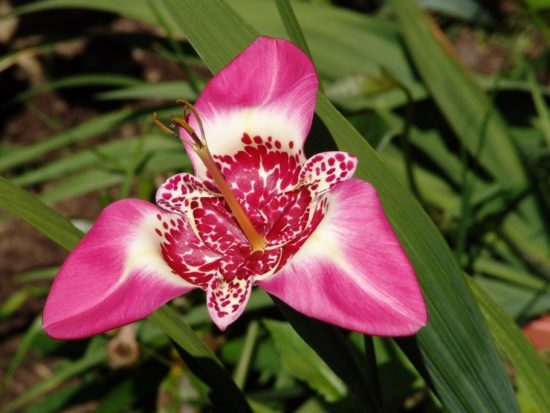

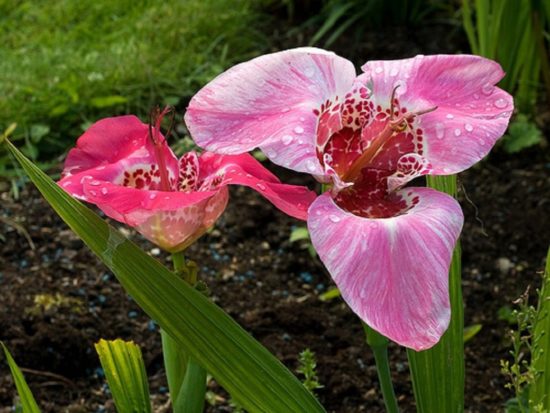
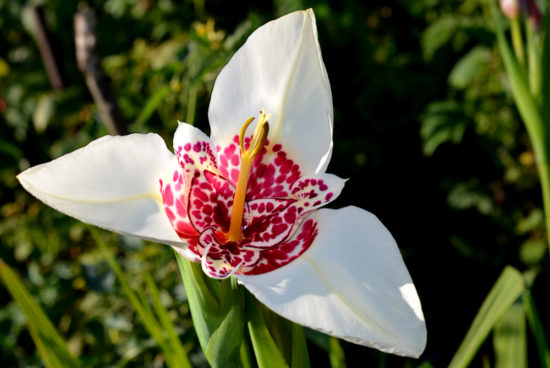
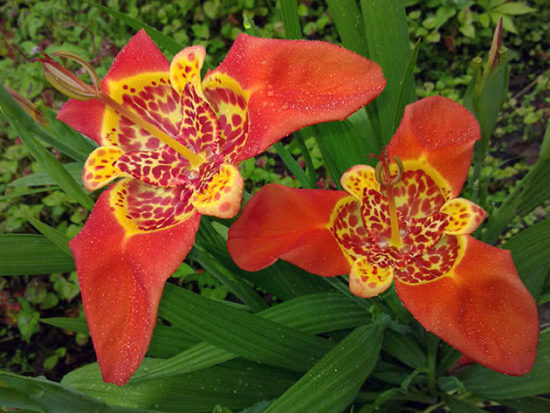
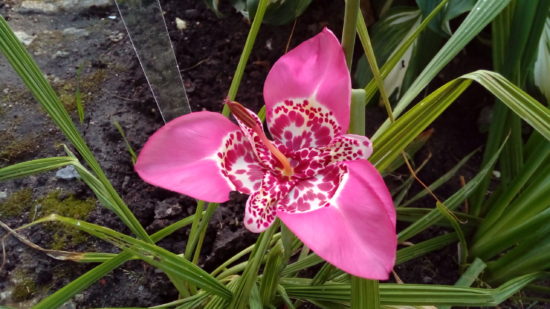
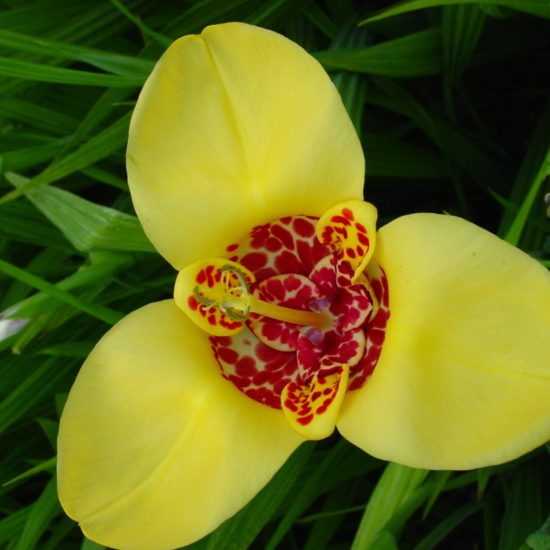
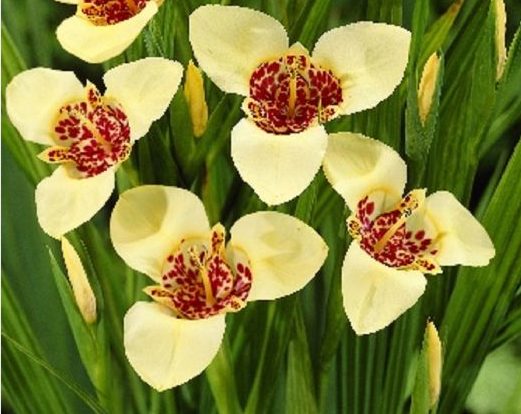

 CUCUMBERS NEVER GET SICK, I'VE BEEN USING ONLY THIS FOR 40 YEARS! I SHARE A SECRET WITH YOU, CUCUMBERS ARE LIKE THE PICTURE!
CUCUMBERS NEVER GET SICK, I'VE BEEN USING ONLY THIS FOR 40 YEARS! I SHARE A SECRET WITH YOU, CUCUMBERS ARE LIKE THE PICTURE! You can dig a bucket of potatoes from each bush. Do you think these are fairy tales? Watch the video
You can dig a bucket of potatoes from each bush. Do you think these are fairy tales? Watch the video
 How our fellow gardeners work in Korea. There is a lot to learn and just fun to watch.
How our fellow gardeners work in Korea. There is a lot to learn and just fun to watch. Eye trainer. The author claims that with daily viewing, vision is restored. They don't charge money for views.
Eye trainer. The author claims that with daily viewing, vision is restored. They don't charge money for views. A 3-ingredient cake recipe in 30 minutes is better than Napoleon. Simple and very tasty.
A 3-ingredient cake recipe in 30 minutes is better than Napoleon. Simple and very tasty. Therapeutic exercises for cervical osteochondrosis. A complete set of exercises.
Therapeutic exercises for cervical osteochondrosis. A complete set of exercises. Which indoor plants match your zodiac sign?
Which indoor plants match your zodiac sign? What about them? Excursion to German dachas.
What about them? Excursion to German dachas.
Tell me, is it possible to leave tigridia bulbs in the ground for the winter in the middle zone? Maybe they will overwinter.
No, Tigridia bulbs in the middle zone do not overwinter in open ground.
I tried leaving tigridia bulbs in the ground over the winter. I didn’t even find them in the spring.
Tasya, I understand that you grew tigridia. What can you say about this flower? I liked it, but it bothers me that the flowering lasts one day. Is it worth planting?
Rightly confusing. It makes sense to plant this flower in large quantities in one place. Well, at least 10 onions. Otherwise there will be few flowers. I can't say that he disappointed me, but I expected much more.
How decorative is the tigridia bush itself, without flowers?
The bush itself without flowers is not very beautiful; the eye will glance at it and not linger. It's a different matter with flowers.
I also grew tigridia, albeit in a pot. I planted 3 bulbs in one pot, they bloomed by the end of summer. The flowering was simply gorgeous, but very short and fleeting.
Yes, Rita, one-day flowering is the main drawback of this flower.
Last year I dug up about 20 bulbs and stored them in the sand, like gladioli. In the spring it was impossible to look at the onions without tears, they were all wrinkled, dry, I thought they were all gone. To my surprise, 12 of them sprouted, and now I’m waiting for them to bloom.